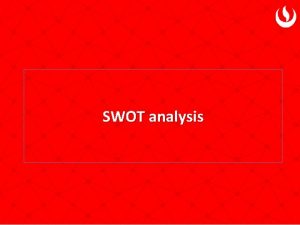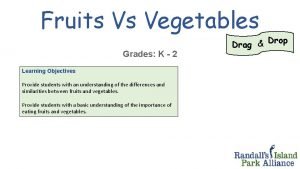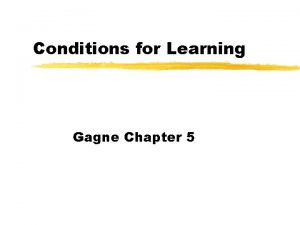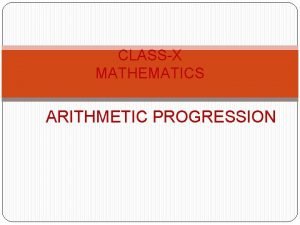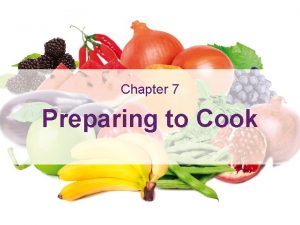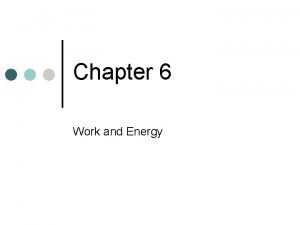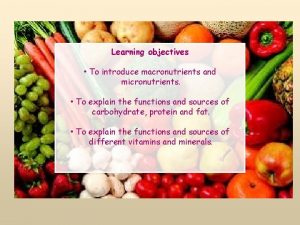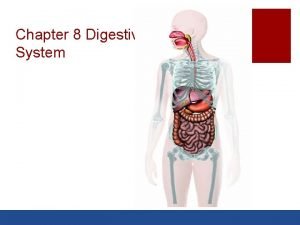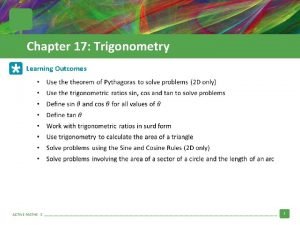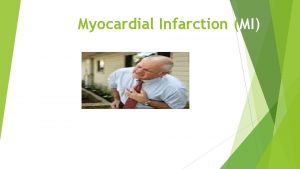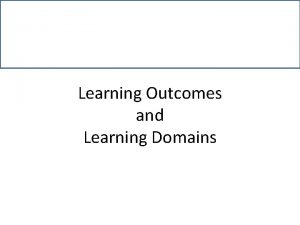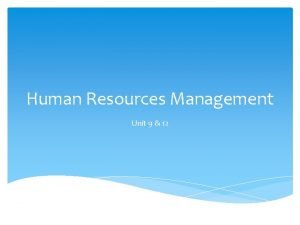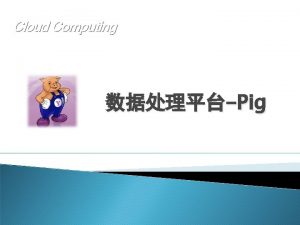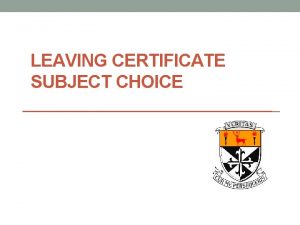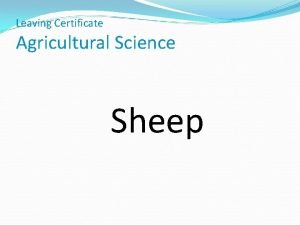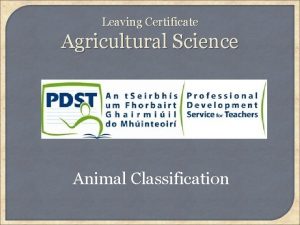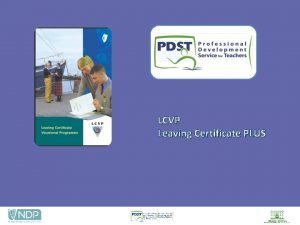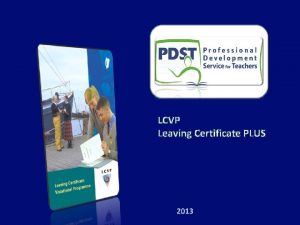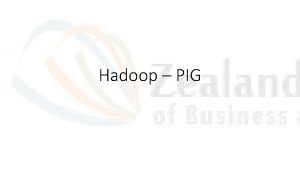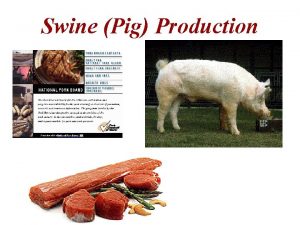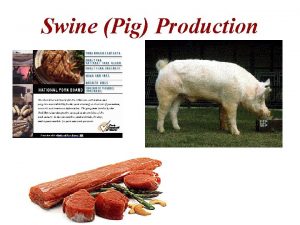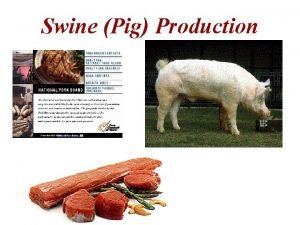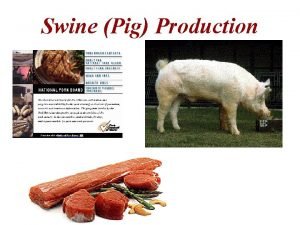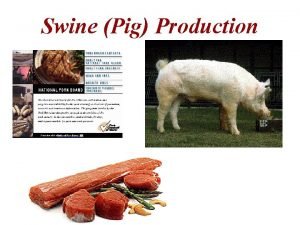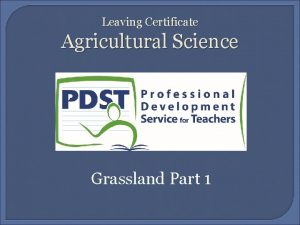LEAVING CERTIFICATE AGRICULTURAL SCIENCE Pig Production LEARNING OUTCOMES























































- Slides: 55

LEAVING CERTIFICATE AGRICULTURAL SCIENCE Pig Production

LEARNING OUTCOMES In this unit you will learn about § Breeds of Pig and their Characteristics. § Dental Formula § Gestation period, oestrous cycle (duration & length) § Target weights. § The management of a bonham from birth to slaughter. § The management of the dry and in young sow. § Diseases of pigs

PIG FACTS 1. 5 million pigs in Ireland Thats 0. 2% of world pig Population. 941. 2 Million Pigs World Wide Products: § Bacon § Pork § Leather, etc

BREEDS OF PIGS- LANDRACE Good Conformation Long body Floppy Ears Yield valuable back bacon & Pork, small shoulders & large hams.

LANDRACE

THE LARGE WHITE British Origin Fast Growth Rate High Prolificy Good Food Conversion Ratio Good Meat Quality Erect Ears

LARGE WHITE

OUTDOOR PIG BREEDS Most pigs in Ireland are raised indoors but on some farms they are raised outside. The Landrace and Large White are not suitable for outdoor pig farming. Outdoor pig breeds include: § § § The Duroc The Saddleback Gloucestor Old Spot Tamworth Piétrain

SADDLEBACK

DUROC

GLOUCESTOR OLD SPOT

TAMWORTH

PIÉTRAIN

PIG FACTS Monogastric Bonhams weighs 1. 0 – 1. 5 kg at birth. Average litter size is 11. Bonhams reach slaughter weight of 82 kg in 6 mths. (reared indoors) Both sexes reach puberty at 6 months Fully mature pigs weigh 140 -200 kg Even toe ungulates Phylum Chordata

GESTATION & OESTROUS Gestation Period 114 days (3 months, 3 Weeks, 3 Days) Oestrous cycle is 21 days Lasts 2 -3 days

DENTAL FORMULA- PIG Incisors, Canines, Premolars, Molars. 3143 X 2



LEARNING CHECK. . Name 2 pig breeds and state their charectoristcs. What is the average weight at birth of a bonham? What is the gestation period of a sow? What is the length of the oestrous of a sow? How long does it last? What is the average litter size?

FOOD CONVERSION RATIO Is the ratio of food consumed to live weight gained. An FCR of 2 means that for every 2 kg of food eaten an animal gains 1 kg of live weight. Low FCR means good feed efficiency 80% of costs are attributed to feed costs Aim FCR 1. 75 weaners Aim FCR 3. 25 for fatteners

FACTORS AFFECTING FCR 1. 2. 3. 4. 5. Breed – boars can confer low FCR values to their offspring. Health- only healthy pigs can fully achieve their potential to utilise feed efficiently Housing – it is important to reduce heat loss so as the pig can use the food to put on flesh rather than trying to maintain constant temp. Well insulated houses. Infa –red lamps Diet- range of rationed suited to bonhams, weaners & fatteners. Rations should balanced quantities of energy, protein, minerals & vitamins. Amount of Essential Amino Acids Management skills of farmers

CRISS-CROSS BREEDING Sire Dam Progeny Use of Progeny LR LW x LR LR x (LW x LR) All males and most females fattened Selected females often kept for breeding LW LR x (LW x LR) LW x (LR x LW x LR) All males and most females fattened Selected females often kept for breeding LR LW x (LR x LW x LR) LR x (LW x LR x LW x LR) All males and most females fattened Selected females often kept for breeding

CRISS-CROSS BREEDING Small numbers of purebred boars of each breed are kept Boars are mated alternatively with crossbred sows Maintain hybrid vigour Boars replaced every two years to prevent inbreeding Animals that are produced are very suitable for fattening

LEANING CHECK. . 1. 2. 3. 4. What do the letters FCR stand for? List 5 factors that affect FCR. Describe Criss-Cross Breeding. What is meant by hybrid Vigour?

TYPES OF PRODUCTION UNITS Integrated Pig Production Units § consist of a (A) breeding and rearing unit with its herd of sows with accompanying bonhams (B) a fattening unit used to bring pigs from weaning to slaughter weights. § They are self contained- this lessens the risk of disease entry & eliminates transport stresses on pigs Outdoor Pig Production § Smaller scale. Animals move between indoor space and grassland (which they dig up). § Higher level of disease and lower growth rate,

PIG PRODUCTION IN IPU’S Sow has to produce at least 2 litters a year 20 weaners In Young Sow She is housed in a dry sow house Fed once per day(2. 5 kg) In early pregnancy some sows are over thin because they have reared a big litter- these have to be given extra feeding to bring them to proper weight In the final 3 -4 weeks sows are fed an extra 0. 5 kg/day to ensure strong healthy bonhams & good milk production A week before farrowing date the sow is moved to the farrowing unit.

DRY SOW HOUSE

FARROWING UNIT § Where litter is born. § Stays there for 4 -7 weeks. § The sow is washed, deloused & disinfected and put in a clean disinfected farrowing unit about 1 week prior to farrowing date. § The house is maintained at a temperature of 20 o C. § It is draught free § Infra red lamp § She must be observed to insures she farrows without difficulty


FARROWING Veterinary assistance should be obtained if problems arise Farrowing crate is designed to allow the sow to farrow with minimum risk to the bonhams. Stand up- access to for suckling & Infa red lamp. It takes about 20 minutes per bonhams to farrow. The bonham amazing selects a teat when born and sucles that teat for the remaining time.

SUCKLING PERIOD Immediately after birth bonhams front teeth are broken off to protect the sows teats from injury. 2 -3 days after birth they are injected with iron to prevent anaemia The bonhams suckle for 5 -6 weeks. The sow is fed suckling ration at a rate of 1. 8 kg + 0. 5 kg /bonham/day. The sow only has enough milk for 30 days. After 5 -7 days creep ration is scattered on the floor Separate supplies of water are given

SUCKLING

FARROWING HOUSE

TAIL DOCKING & CASTRATION Bonhams tails are cut off at day 3. . Prevents them biting their tails due to boredom. Bonhams are castrated only if they are being slaughter at an older age. This prevents meat Taint. .

LEARNING CHECK. . What happens in the farrowing unit? Where are the in young sows prior to farrowing? Explain why the following are carried out? § § Injected with Iron Tails cut off Teeth Broken Placed under an infa red lamp Explain their feeding regime. What is meant by an integrated system?

POST WEANING SOW MANAGEMENT After weaning, the sow is moved back to the dry sow house. She comes back into oestrous within 5 -7 days of weaning. A boar is released once a day to detect sows heat. When detected, sow is removed and served by appropriate boar/AI twice within 24 days. Double servicing increases conception rates & litter sizes. If comes back into oestrous in 21 days, serviced again. Sows are culled at 4 -5 years old or when health declines.

THE BOAR

BOAR CLOSE TO SOW

FRESH PIG SEMEN FOR AI

IN HEAT SOW. When the sow is in heat she remains very still with ears erect and close together.

MANAGEMENT & FEEDING OF WEANERS § Bonhams are weaned abruptly at 5 -6 weeks § Those of same weight are placed in groups. § These groups are moved to weaner houses. § They are stocked at sufficiently high density to allow house temp. to be at 24 o C. § Houses have under floor insulating & low roofs to conserve heat. § Weaners are fed weaner ration ad lib & water is available. § Weaning weight increases from 9 kg to 32 kg § Stocking density has to be re-evaluated to avoid over crowding

WATER SUPPLY

THE WEANER HOUSE

LEARNING CHECK. . At what weight are bonhams weaned at? What age are bonhams when they are weaned? How is it carried out? State the feeding regime for a weaner. Describe the term Double servicing

MANAGEMENT & FEEDING FATTENERS When weaners are moved to fattening houses, they are again mixed according to size. This is the last house before slaughter. They are stocked at a density (lower) required to maintain the correct temperature 22 o C. Room to walk around. Fattening houses have low roofs and very good insulation.

FATTENERS �Fattener ration is fed ad lib. 15% protein. �Water is available. �Many producers restrict feeding for the last few weeks prior to slaughter to restrict fat deposition & improve carcase grade. �Sent for slaughter when weigh 82 kg or when they have the degree of finish required for factory. �Farmers assess it visually or by use of ultrasonic devices.

FATTENERS & FATTENER RATION

FATTENER HOUSE

CONDITION SCORING Condition scoring is carried out by farmers to assess if an animal is ready for slaughter or fit for mating. It is carried out by running a hand along the rib cage and back bone to assess the level of fat cover. In a scale of 0 to 9, 0 is extremely thin and 9 is extremely fat. Scores in the middle are most desirable. It is very subjective and requires a lot of experience. It is on a scale of 0 -5 for cows and sheep.

LEARNING CHECK. . 1. 2. 3. 4. 5. 6. What is meant by Critical Temperature? What are the critical temperatures in the farrowing Unit, the weaner house and the fattening house? Name the house that fatteners are kept in. State the feeding requirements for fatteners. At what weight are fatteners slaughtered at? What is condition scoring and what is the best condition score for a fattener?

REPLACEMENT GILTS § Gilts are female pigs which have not yet had their first litter selected at birth for their excellent conformation and breeding. § As fatteners approach slaughter weight those with the best conformation & health are selected as breeding herd replacements. § They are housed together for a further 4 -6 weeks before being moved to dry sow house. § They will come into oestrous and enter the production cycle.

REPLACEMENT GILT

GILT – EAR NOTCHING Notched ear means that this pig has been selected at birth for breeding purposes by the farmer.

DIET OF MONOGASTRIC V RUMINANT § Non –ruminant § Non-roughage § Balanced ration – high protein, vitamin A, D & minerals (iron) § Housed in doors, therefore lacking minerals from the soil. § Wide variety of materials in ration to make up concentrated ration Ruminant Roughage Grazed out doors- grasshigh quality grass =complete food Less variety of materials in ration

DISEASES OF PIGS Commercially reared and fattened indoor pigs are subject to a much less number of diseases than cattle or sheep. Reasons : 1. Pigs live in a controlled environment with little or no contact with soil or vegetation. 2. temp, humidity, hygiene & diet are all controlled and kept at levels optimum for growth & development. 3. Usually self contained except for occasional purchases of boars The controlled environment can grow and spread disease rapidly. Hygiene is crucial. Disinfectant baths.
 Production process flow chart
Production process flow chart History syllabus leaving cert
History syllabus leaving cert Primary school leaving examination in chinese
Primary school leaving examination in chinese Leaving certificate
Leaving certificate Characteristics of agricultural production
Characteristics of agricultural production Indian agricultural research institute
Indian agricultural research institute Math is my favorite subject
Math is my favorite subject Learning outcomes examples english
Learning outcomes examples english Water cycle learning outcomes
Water cycle learning outcomes Learning objectives for notice writing
Learning objectives for notice writing Objective of swot analysis
Objective of swot analysis Rhymes with understand
Rhymes with understand Planning goals and learning outcomes
Planning goals and learning outcomes Photolysis of water
Photolysis of water Learning objectives of photosynthesis
Learning objectives of photosynthesis National competency-based teacher standards
National competency-based teacher standards Objectives of linear equations in one variable
Objectives of linear equations in one variable Learning outcomes generator
Learning outcomes generator Objectives of teaching direct and indirect speech
Objectives of teaching direct and indirect speech Purpose of learning outcomes
Purpose of learning outcomes Objectives of input output management
Objectives of input output management Ib psychology learning outcomes
Ib psychology learning outcomes Essay writing learning outcomes
Essay writing learning outcomes Learning outcomes of holy week
Learning outcomes of holy week Holy week objectives
Holy week objectives Headstart early learning outcomes framework
Headstart early learning outcomes framework Learning objectives of fruits and vegetables
Learning objectives of fruits and vegetables Gagne learning outcomes
Gagne learning outcomes Arithmetic progression mind map
Arithmetic progression mind map A gift of chappals
A gift of chappals Learning outcomes of work and energy
Learning outcomes of work and energy Learning objectives of profit and loss
Learning objectives of profit and loss Cooking learning outcomes
Cooking learning outcomes 7 domains of ppst and strands
7 domains of ppst and strands Learning outcomes prescribe
Learning outcomes prescribe Learning objectives of work and energy
Learning objectives of work and energy Cas learning outcomes
Cas learning outcomes Conclusion of learning outcomes
Conclusion of learning outcomes Pythagoras
Pythagoras Objectives of vitamins
Objectives of vitamins Digestive system learning objectives
Digestive system learning objectives Learning outcomes of trigonometry
Learning outcomes of trigonometry Pathophysiology of angina
Pathophysiology of angina Hot seating questions examples
Hot seating questions examples Mqf learning outcomes domains
Mqf learning outcomes domains Hindu writing
Hindu writing Learning outcomes of myself
Learning outcomes of myself Human resources learning outcomes
Human resources learning outcomes Business communication systems gcse
Business communication systems gcse Objectives of email communication
Objectives of email communication Define training program
Define training program Examples of learning outcomes
Examples of learning outcomes Objective of mental health
Objective of mental health Affective objectives examples
Affective objectives examples Learning outcomes definition
Learning outcomes definition Slidetodoc.com
Slidetodoc.com










